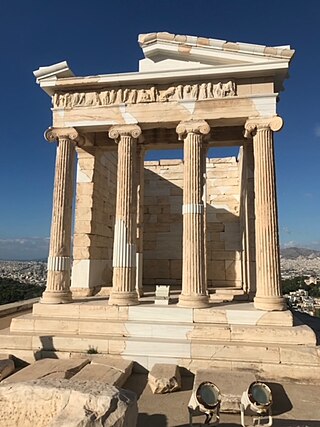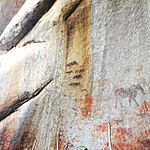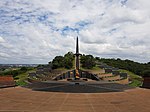
In the United Kingdom, a scheduled monument is a nationally important archaeological site or historic building, given protection against unauthorised change.

Historic preservation (US), built heritage preservation or built heritage conservation (UK) is an endeavor that seeks to preserve, conserve and protect buildings, objects, landscapes or other artifacts of historical significance. It is a philosophical concept that became popular in the twentieth century, which maintains that cities as products of centuries' development should be obligated to protect their patrimonial legacy. The term refers specifically to the preservation of the built environment, and not to preservation of, for example, primeval forests or wilderness.

Cultural heritage is the heritage of tangible and intangible heritage assets of a group or society that is inherited from past generations. Not all heritages of past generations are "heritage"; rather, heritage is a product of selection by society.
The National Administration of Cultural Heritage is an administrative agency affiliated with the Ministry of Culture and Tourism of the People's Republic of China. It is responsible for the development and management of museums as well as the protection of cultural relics of national importance.

The International Centre for the Study of the Preservation and Restoration of Cultural Property (ICCROM) is an intergovernmental organization dedicated to the preservation of cultural heritage worldwide through training, information, research, cooperation and advocacy programmes. It aims to enhance the field of conservation-restoration and raise awareness to the importance and fragility of cultural heritage.
Cultural heritage of Serbia represents the totality of national cultural heritage in Serbia as defined by Serbia's Law on Cultural Goods. Some of national heritage sites in Serbia are also World Heritage Sites.
Immovable Cultural Heritage of Exceptional Importance are those objects of Immovable cultural heritage that enjoy the highest level of state protection in the Republic of Serbia. Immovable Cultural Heritage is classified as being of Exceptional Importance upon decision by the National Assembly of Serbia. They are inscribed in the Central Register of Immovable cultural property maintained by the Institute for the Protection of Cultural Monuments of Serbia. Objects of Immovable cultural heritage have to fulfill one or more of those criteria defined in the Law on Cultural Heritage of 1994 in order to be categorized as being "of exceptional importance":
- exceptional importance for social, historical or cultural development of the people, or for the development of its natural environment;
- evidence of important historic events or persons and their work;
- unique (rare) example of human creativity of the time or a unique example from the natural history;
- great influence on the development of society, culture, technology, or science;
- exceptional artistic or aesthetic value.

The Philippine Registry of Cultural Property, abbreviated as PRECUP, is a national registry of the Philippine Government used to consolidate in one record all cultural property that are deemed important to the cultural heritage, tangible and intangible, of the Philippines. On June 11, 2018, the entries in the newly updated PRECUP was at 3,921. Additionally, 1,259 out of 1,715 LGUs, or 73 percent of LGUs have established local cultural inventories (LCI).

The National Institute of Cultural Heritage of Poland is a Polish governmental institution responsible for documenting cultural property and the intangible cultural heritage, as well as for supporting and coordinating their protection.

Cultural properties of Indonesia are those items defined by Indonesian law as of "important value for history, science, and culture", and include both man-made artefacts and natural objects. The cultural properties number more than 8,000 and include ancient Hindu and Buddhist temples, mosques, historic colonial buildings, forts, art galleries, national parks and beaches. A number of the sites are World Heritage Sites.

The cultural heritage of Slovakia is protected and promoted in accordance with the Law on the protection of monuments and historic sites (2002). Article 2 defines monuments and historic sites as those movable and immovable cultural properties that have been declared as national Cultural Heritage Monuments. Cultural Heritage Monuments are declared by the Ministry of Culture after proposal by the Monuments Board. A central register is kept by the Monuments Board, comprising a register of (1) movable cultural heritage monuments; (2) immovable cultural heritage monuments ; (3) protected historic reserves ; (4) protected historic zones. As of 31 December 2010, 14,818 cultural monuments have been declared. In addition, as of January 2003, 2,828 town reserves and 757 folk architecture reserves have been declared.

Heritage Western Cape (HWC) is a provincial heritage resources authority established by the Minister of Cultural Affairs and Sport of the government of the Western Cape province in South Africa. It is a public entity set up under the terms of the National Heritage Resources Act. It is mandated to care for that part of South Africa's national estate that is of provincial and local significance in the Western Cape. It may delegate responsibility for heritage resources of local significance to competent municipal governments.
The cultural monuments of the Czech Republic are protected properties designated by the Ministry of Culture of the Czech Republic. Cultural monuments that constitute the most important part of the Czech cultural heritage may be declared national cultural monuments by a regulation of the Government of the Czech Republic. Government may also proclaim a territory, whose character and environment is determined by a group of immovable cultural monuments or archaeological finds, as a whole, as a monument reservation. Ministry of Culture may proclaim a territory of a settlement with a smaller number of cultural monuments, historical environment or part of a landscape area that display significant cultural values as a monument zone.
Mounir Bouchenaki is an Algerian archaeologist and incumbent Director of the Arab Regional Centre for World Heritage. He was Director-General of ICCROM from 2006 to 2011, UNESCO's Assistant Director General for Culture (2000-2006), Director of the World Heritage Centre (1998-2000), Director of UNESCO's Cultural Heritage Division (1990-2000). In January 2011, he was named honorary special adviser of UNESCO Director-General Irina Bokova and of ICCROM Director-General.

The conservation and restoration of archaeological sites is the collaborative effort between archaeologists, conservators, and visitors to preserve an archaeological site, and if deemed appropriate, to restore it to its previous state. Considerations about aesthetic, historic, scientific, religious, symbolic, educational, economic, and ecological values all need to be assessed prior to deciding the methods of conservation or needs for restoration. The process of archaeology is essentially destructive, as excavation permanently changes the nature and context of the site and the associated information. Therefore, archaeologists and conservators have an ethical responsibility to care for and conserve the sites they put at risk.

The Commission to Preserve National Monuments of Bosnia and Herzegovina, abbr. KONS, is Bosnia and Herzegovina commission (agency) which declares and registers national heritage monuments/sites, including natural/urban/architectural assembles, immovable and movable heritage of historical and cultural importance to Bosnia and Herzegovina, as an institution at state level. The sites of exclusively natural heritage are not subject of Annex 8 and the KONS.
Webber Ndoro was the Director-General of ICCROM from 2017 to 2023. He is considered the first professional Zimbabwean cultural heritage manager, and amongst the first trained Zimbabwean archaeologists.

According to the Loi sur le patrimoine culturel du Québec, the cultural heritage of Quebec is made up of deceased historical figures, historic places and events, heritage documents, buildings, objects and sites, heritage cultural landscapes and intangible heritage.

















